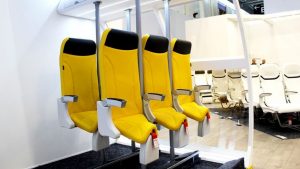 Airlines are constantly looking for new ways to cut costs and increase profits. One of the latest strategies involves the use of a smaller seats. By using smaller seats, airlines can squeeze more passengers into their jets, which means more revenue earned per flight. However, one company has proposed a bold new idea that could take this trend to the next level: standing seats.
Airlines are constantly looking for new ways to cut costs and increase profits. One of the latest strategies involves the use of a smaller seats. By using smaller seats, airlines can squeeze more passengers into their jets, which means more revenue earned per flight. However, one company has proposed a bold new idea that could take this trend to the next level: standing seats.
Pioneered by the Italian company Aviointeriors, the standing seats — as show in the image to the left — are designed so that passengers can stretch their legs while minimizing space requirements. Known as SkyRider 2.0, Aviointeriors says the seats provide airlines with ultra-high density usage of cabin space.
The SkyRider 2.0 seats aren’t exactly new. On the contrary, Aviointeriors unveiled the design back in 2010. Airlines showed little interest in the seats back then, however, so Aviointeriors didn’t pursue it. But now the Italian company is hoping to sell the SkyRider 2.0 seats to various airlines throughout the world, providing them with a simple way to increase profits by squeezing more passengers into their jets.
So, just how many more passengers can airlines fit into their jets with the new SkyRider 2.0 seats? Aviointeriors says that for most jets, the seats will provide a 20% increase in passenger capacity. This means airlines can expect to sell up to 20% more tickets for each flight equipped with these seats. That’s not the only benefit of the SkyRider 2.0 seats, though. Aviointeriors also says that the compact seats weight 50% less than the market’s current standard economy-class seats.
“The design of this seat enables to increase the passenger number by 20% allowing increasing profits for airline companies,” explained Aviointeriors. “Furthermore, Sky Rider 2.0 weighs 50% less than standard economy class seats and the reduced number of components enable minimum maintenance costs.”
Of course, the new compact seats may create discomfort for some passengers. According to one person who reviewed the seats, the front rows were comfortable. When sitting in the back rows, however, the seats caused knee pain.
Whether or not airlines adopt the SkyRider 2.0 seats remains to be seen. Earlier this year, a U.S. appeals court said the Federal Aviation Administration (FAA) must reconsider its decision about regulating the size of airline seats. The FAA had previously said that it would not regulate the size of airline seats. But new concerns regarding the safety and health effects of small seats prompted the court of appeals to issue a statement in which it said that the FAA must now reconsider this decision.



